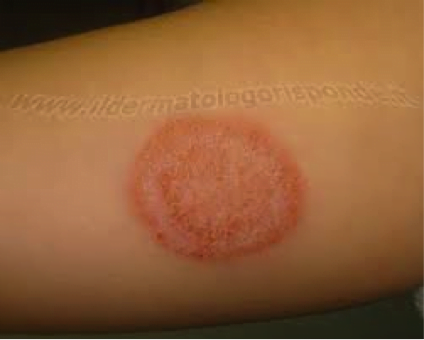My criticism is two-fold.
Firstly, treating blindly is poor medicine.
What if you have the wrong diagnosis?
When presented with an annular erythema with scale a number of diagnoses run through my mind. Tinea corporis, psoriasis, erythema annulare centrifugum, allergic contact dermatitis, lichen planus, cutaneous T-cell lymphoma, eczema, subacute cutaneous lupus erythematosus, discoid lupus erythematosus, pityriasis rosea, secondary syphilis, polymorphous light eruption, annular seborrheic dermatitis, erythrokeratodermia variabilis, leprosy, etc.
Yes, tinea corporis is one of these diagnoses, but very often the diagnosis is unclear. In these cases I will do a fungal scraping, KOH examination, and skin biopsy then wait for the results before initiating treatment.
In addition to the list outlined above, more dangerous pathology such as cutaenous T-Cell lymphoma can be treated as tinea or psoriasis for many years before an accurate diagnosis is made. Occasionally there is an obvious diagnosis of a dermatophyte infection (i.e. tinea cruris with horrific onychomycosis, tinea pedis, and a new annular erythema with a characteristic leading edge of scale in the groin) and the differential diagnosis is short. Even then I will always do a fungal scraping and have the patient follow up to ensure treatment is effective.
Secondly, combination steroid/antifungal products should not be used for superficial dermatophyte infections.
There is industry-sponsored evidence to support the use of these lucrative combination products and short term clinical cure is an easy endpoint to achieve when you add an anti-inflammatory agent. However, it raises the question – what is the risk of rebound upon discontinuation? This can result in steroid dependency to quell inflammation caused by a dermatophyte infection.
The use of even mid-potency topical steroids can have serious consequences if used chronically, and sometimes even from short term use. There is a real risk of atrophy, telangiectasia, striae, purpura, bruising and hair growth in addition to HPA axis suppression, growth retardation, immunosuppression and impaired wound healing (although perhaps this is more theoretical).
A product like lotriderm (topical azole and betamethasone diproprionate) is often prescribed by primary care docs unsure of how to treat a rash.
Betamethasone diproprionate is a class 1/2 steroid (meaning highest potency), very different from betamethasone valerate, an entirely different, milder, medication.
I recently reviewed a case of a teenage girl with horrific striae, erythema, and telangiectasia between her breasts. She had been prescribed lotriderm for a presumed fungal infection, and as the area continued to be red (which was, in fact, atrophy from the treatment) she continued to use it. Unfortunately for her (and the prescribing doctor), her disfiguring stretch marks are permanent. This is not a unique story.
In summary:
- If a fungal infection is suspected, confirm the diagnosis prior to initiating treatment.
- If the scraping is negative and the diagnosis is unclear, consider referral to dermatology for a skin biopsy for diagnosis (+/- repeat scraping).
- If the fungal scraping is positive, treat with antifungal therapy, monotherapy.
- Do not use corticosteroids on dermatophyte infections.
- Use caution when prescribing strong topical steroids.
-Posted by Dr. Teresa Chan on behalf of Dr. Erin Dahlke
Suggested Papers for Further Reading:
1. Greenberg, H. L., Shwayder, T. A., Bieszk, N., & Fivenson, D. P. (2002). Clotrimazole/betamethasone diproprionate: a review of costs and complications in the treatment of common cutaneous fungal infections. Pediatric dermatology,19(1), 78-81. DOI: 10.1046/j.1525-1470.2002.00027.x
2. Alston, S. J., Cohen, B. A., & Braun, M. (2003). Persistent and recurrent tinea corporis in children treated with combination antifungal/corticosteroid agents. Pediatrics, 111(1), 201-203. doi: 10.1542/peds.111.1.201



